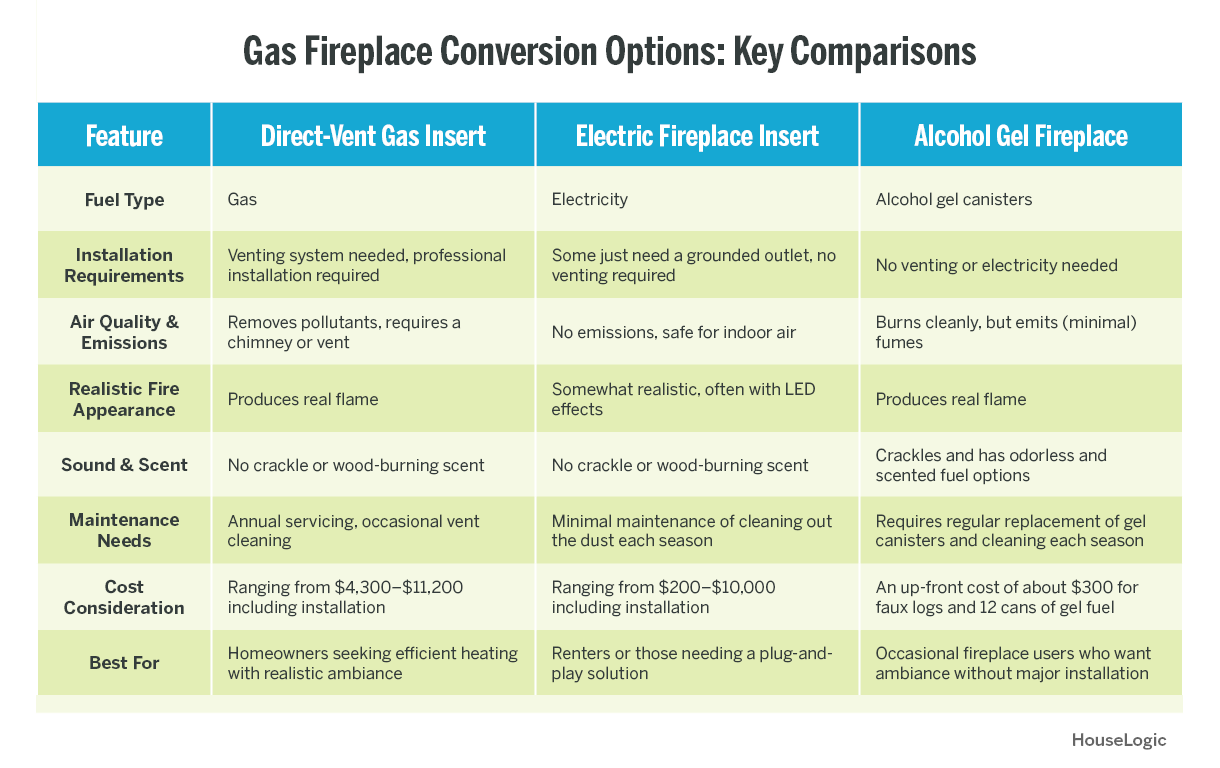There’s almost nothing better in fall and winter than the crackle, scent, and warmth of a wood-burning fireplace. It can be a romantic and coveted household feature. But it's not the most earth-friendly fireplace option and can be more hassle than it's worth. If you're considering making the switch to a gas fireplace unit, you'll need to consider a few aspects before you get started, like fuel type, costs maintenance, and more. Plus, it's important to think through gas fireplace installation before you start since the install process will be different if you're adding a new gas fireplace vs. updating an older style gas fireplace unit.
Convert Your Fireplace to Gas
Fireplaces may be aesthetically pleasing, but these days, they don't add to the appraised value of a home, according to appraisers. That said, if you enjoy a fireplace, you might want to indulge your personal preference anyway. You have a few gas fireplace options other than a high-maintenance, environmentally unfriendly wood-burning version.
Here's some info on three gas fireplace types:
#1 Direct-Vent Gas Insert Fireplace

A direct-vent gas fireplace is a more efficient heat source than its wood-burning brother. Making the switch from wood to gas also helps protect your in-home air quality.
| Installation | Pro install required to properly vent fumes outside through the roof or wall. Also need a pro plumber to hook up the gas line. Permanent option. |
| Fuel | Gas |
| Pollutants | Flame is behind glass, so pollutants are expelled via the vent, not into the house. |
| Fire | Produces a real fire. |
| Sound and Scent | No crackle or wood-burning scent. |
| Cost | Expensive. Including installation, prices range from $4,300 to $11,200. Since it uses gas, it may well increase your utility bill. But these units produce the heat loss associated with a wood-burning fireplace. To help offset the expense, turn down your thermostat while you're enjoying your fire. |
| Maintenance | Before using each season, have a pro remove the dust that collected inside the fireplace around its internal components and on its glass screen. |
#2 Electric Fireplace Insert

| Installation | Some just need to be plugged into a grounded outlet, so you’ll likely be able to install it yourself. Can be moved to other rooms. |
| Fuel | Electricity. |
| Pollutants | None. |
| Fire | It’s faux for sure, but new models use LED lights to suggest realistic flames. |
| Sound and Scent | No crackle or wood-burning scent. |
| Cost | Moderate. Including installation, prices can range from $200 to $10,000, with most people spending about $1,000. The fireplace will likely increase your electricity bill, but it’ll last years longer than a gas fireplace because there’s no combustible fuel. |
| Maintenance | Before using each season, clean out the dust that is collected inside the fireplace and on its screen (if it has one). As a precaution, remember to unplug all electric gas fireplaces before cleaning. |
#3 Alcohol Gel Fireplace with Faux-Log Insert (Ventless)

| Fuel | Alcohol gel (a combo of isopropyl alcohol, water, salt, and thickeners) is sold in cans, like Sterno; one can burn for up to three hours. |
| Pollutants | Emits heat, steam, and a minute amount of carbon dioxide. To put this in perspective: One fuel brand claims to emit levels of 16 parts per million; for most people, prolonged exposure to levels 70 ppm or higher is dangerous. Although alcohol is considered a clean fuel, if you use the fireplace more than two times a week, air out your home on a regular basis to prevent minimal pollutants from building up. |
| Fire | Produces real flame. |
| Sound and Scent | Crackles like the real thing (thanks to the salt), and fuel is available in odorless and scented options. |
| Cost | Inexpensive to moderate. Faux-log inserts cost about $240 for a set of three, and twelve cans of gel fuel cost about $62. |
| Maintenance | The log insert and fireplace can accumulate dust. Before using each season, you’ll need to remove the log insert and clean inside of the fireplace. Afterwards, wipe down the log insert and replace. |
Note: For any combustible fireplace option, install a carbon monoxide detector in the same room as the fireplace. The device should meet UL 2034 safety standards.

Go Green With Wood to Gas
The transition from wood-burning to gas fireplaces is a modern and eco-friendly shift. It's convenient, efficient and reduces environmental impact. Gas burning fireplaces can enhance your overall heating experience creating that cozy, warm space without all the wood.
